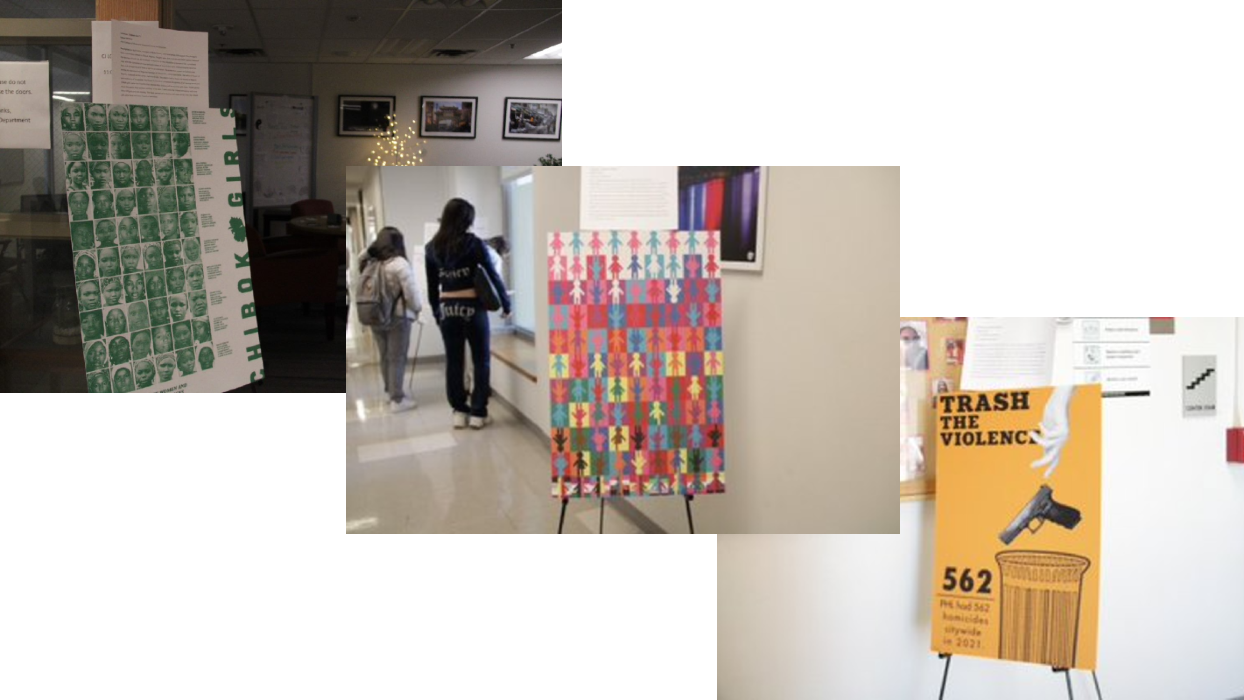On November 9, 2022, Temple University’s College of Liberal Arts hosted a reception for their second annual Justice Through Art Contest. The reception honored the six winners of this year’s contest, with three in the literary category and three in the visual category.
Senior advertising students Raquel Wilkins (she/her), Hannah Tarlov (she/her) and Andrew Flynn (he/him) took home first, second and third place in the visual category, respectively.
In the spring of 2022, Wilkins, Tarlov and Flynn took ADV 3052: Art Direction I with Associate Professor Kathy Mueller. After looking at ways artists such as Emory Douglas, Corita Kent and Shepard Fairey used art for activism, the students were tasked with creating their own work for the contest.
“We engaged in the Justice Through Art competition as an active learning opportunity where students developed knowledge and skill,” Mueller wrote.
Wilkins chose to submit a piece about the kidnapping of 276 schoolgirls from Chibok, Nigeria, in 2014. She formatted it like a school yearbook, with any pictures of the girls she could find and their names on the side. There is a space at the bottom for any girls that couldn’t be identified or haven’t been found.
When coming up with her idea, Wilkins thought about how she would want to be remembered if she was one of the girls.
“I would want people to know that I was in school. That I was getting something that was important to me,” Wilkins said. Most of her work, she said, focuses on giving voices to people who don’t have a platform or who otherwise aren’t allowed to use their own. She is proud to have had the opportunity to depict the beauty and resilience of the Nigerian people, even in the face of tragedy.
Tarlov chose to focus on justice in gender expression. Her piece starts with a simple pattern of recognizable symbols typically used to represent male and female, but gradually uses color and variations of those shapes to show the wide range of ways people express themselves and the intersectionality of those expressions with race and ethnicity.
At the reception, Tarlov was amazed to see her work printed out on such a large board for the first time. She also enjoyed seeing Wilkins’ and Flynn’s final products as well as the literary pieces. “It was really interesting, because all of the pieces were so incredibly different,” she said.
Flynn chose to use what he learned about Emory Douglas when creating his piece. Douglas was the art director for The Black Panther newspaper and often designed in monotone. Flynn wanted to create a work that combined gun violence justice in Philadelphia and his passion for keeping the city clean.
On an orange background, the color for gun violence prevention, Flynn placed a gun being thrown in the trashcan, along with a statistic about homicide in Philadelphia. An important part of his work, he said, is the negative space on the left side that gives the reader’s eyes a break before reading such a heavy statistic.
“When you think of Philadelphia you just make these vast assumptions about how people live their lives,” Flynn said. He is proud to live in the Temple neighborhood and actively looks for ways to interact with his student and nonstudent neighbors alike.
Like Tarlov, Flynn was also excited to see his work printed out so large at the event. He described the reception as being kind of like an art gallery and enjoyed the opportunity for people to view his work without it being for critique purposes like in class with Wilkins and Tarlov.
Wilkins, Tarlov and Flynn are all grateful for the opportunity Mueller gave them to be a part of the contest and are looking forward to graduating in the spring.
“I’m incredibly proud of the students for the learning and growth I witnessed in the classroom, and I congratulate them on their awards in the competition,” Mueller wrote.

